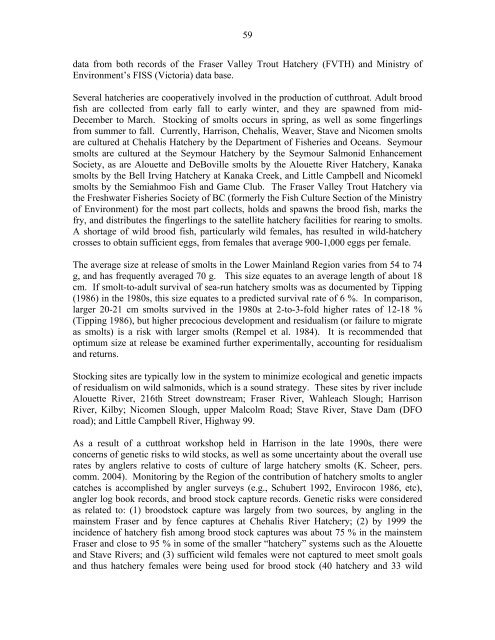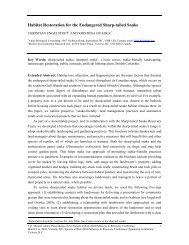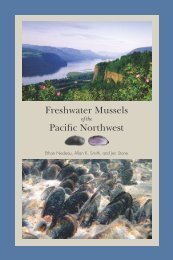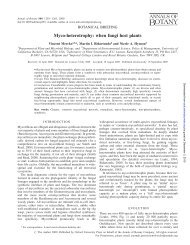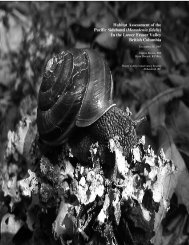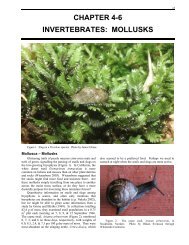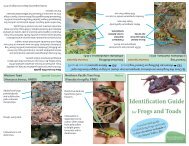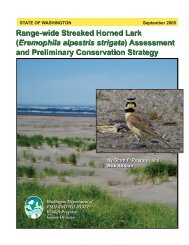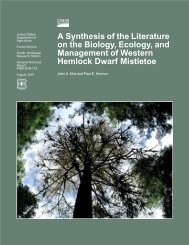Coastal Cutthroat Trout as Sentinels of Lower Mainland Watershed ...
Coastal Cutthroat Trout as Sentinels of Lower Mainland Watershed ...
Coastal Cutthroat Trout as Sentinels of Lower Mainland Watershed ...
Create successful ePaper yourself
Turn your PDF publications into a flip-book with our unique Google optimized e-Paper software.
59data from both records <strong>of</strong> the Fr<strong>as</strong>er Valley <strong>Trout</strong> Hatchery (FVTH) and Ministry <strong>of</strong>Environment’s FISS (Victoria) data b<strong>as</strong>e.Several hatcheries are cooperatively involved in the production <strong>of</strong> cutthroat. Adult broodfish are collected from early fall to early winter, and they are spawned from mid-December to March. Stocking <strong>of</strong> smolts occurs in spring, <strong>as</strong> well <strong>as</strong> some fingerlingsfrom summer to fall. Currently, Harrison, Chehalis, Weaver, Stave and Nicomen smoltsare cultured at Chehalis Hatchery by the Department <strong>of</strong> Fisheries and Oceans. Seymoursmolts are cultured at the Seymour Hatchery by the Seymour Salmonid EnhancementSociety, <strong>as</strong> are Alouette and DeBoville smolts by the Alouette River Hatchery, Kanak<strong>as</strong>molts by the Bell Irving Hatchery at Kanaka Creek, and Little Campbell and Nicomeklsmolts by the Semiahmoo Fish and Game Club. The Fr<strong>as</strong>er Valley <strong>Trout</strong> Hatchery viathe Freshwater Fisheries Society <strong>of</strong> BC (formerly the Fish Culture Section <strong>of</strong> the Ministry<strong>of</strong> Environment) for the most part collects, holds and spawns the brood fish, marks thefry, and distributes the fingerlings to the satellite hatchery facilities for rearing to smolts.A shortage <strong>of</strong> wild brood fish, particularly wild females, h<strong>as</strong> resulted in wild-hatcherycrosses to obtain sufficient eggs, from females that average 900-1,000 eggs per female.The average size at rele<strong>as</strong>e <strong>of</strong> smolts in the <strong>Lower</strong> <strong>Mainland</strong> Region varies from 54 to 74g, and h<strong>as</strong> frequently averaged 70 g. This size equates to an average length <strong>of</strong> about 18cm. If smolt-to-adult survival <strong>of</strong> sea-run hatchery smolts w<strong>as</strong> <strong>as</strong> documented by Tipping(1986) in the 1980s, this size equates to a predicted survival rate <strong>of</strong> 6 %. In comparison,larger 20-21 cm smolts survived in the 1980s at 2-to-3-fold higher rates <strong>of</strong> 12-18 %(Tipping 1986), but higher precocious development and residualism (or failure to migrate<strong>as</strong> smolts) is a risk with larger smolts (Rempel et al. 1984). It is recommended thatoptimum size at rele<strong>as</strong>e be examined further experimentally, accounting for residualismand returns.Stocking sites are typically low in the system to minimize ecological and genetic impacts<strong>of</strong> residualism on wild salmonids, which is a sound strategy. These sites by river includeAlouette River, 216th Street downstream; Fr<strong>as</strong>er River, Wahleach Slough; HarrisonRiver, Kilby; Nicomen Slough, upper Malcolm Road; Stave River, Stave Dam (DFOroad); and Little Campbell River, Highway 99.As a result <strong>of</strong> a cutthroat workshop held in Harrison in the late 1990s, there wereconcerns <strong>of</strong> genetic risks to wild stocks, <strong>as</strong> well <strong>as</strong> some uncertainty about the overall userates by anglers relative to costs <strong>of</strong> culture <strong>of</strong> large hatchery smolts (K. Scheer, pers.comm. 2004). Monitoring by the Region <strong>of</strong> the contribution <strong>of</strong> hatchery smolts to anglercatches is accomplished by angler surveys (e.g., Schubert 1992, Envirocon 1986, etc),angler log book records, and brood stock capture records. Genetic risks were considered<strong>as</strong> related to: (1) broodstock capture w<strong>as</strong> largely from two sources, by angling in themainstem Fr<strong>as</strong>er and by fence captures at Chehalis River Hatchery; (2) by 1999 theincidence <strong>of</strong> hatchery fish among brood stock captures w<strong>as</strong> about 75 % in the mainstemFr<strong>as</strong>er and close to 95 % in some <strong>of</strong> the smaller “hatchery” systems such <strong>as</strong> the Alouetteand Stave Rivers; and (3) sufficient wild females were not captured to meet smolt goalsand thus hatchery females were being used for brood stock (40 hatchery and 33 wild


